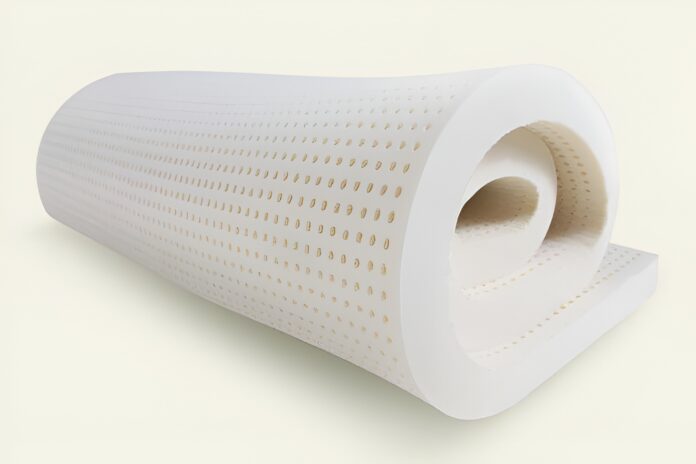Everyone loves the embrace of a cool, breathable bed, especially when summer nights turn the bedroom into a sauna.
If you sleep hot, an organic bed topper can turn a sweaty struggle into a restorative ritual. Today, three materials dominate the eco‑friendly topper market: organic latex, wool, and cotton.
Each brings a different cocktail of temperature regulation, feel, and maintenance quirks. Below, we unpack the science so you can match your micro‑climate, sleep style, and sustainability goals to the right topper.
At‑a‑Glance Comparison
| Feature | Organic Latex | Organic Wool | Organic Cotton |
| Primary Cooling Mechanism | Open‑cell ventilation & buoyant airflow | Moisture‑wicking & phase‑change insulation | Breathable weave allows passive airflow |
| Feel & Support | Springy, medium‑firm, fast response | Plush “cloud” loft, gentle contour | Flat, firm, compresses over time |
| Best For | Combo or back sleepers needing bounce | Side sleepers & those in humid climates | Stomach sleepers or anyone wanting vegan firmness |
| Care | Spot clean, air‑dry, flip | Sun‑air monthly, spot clean | Machine wash (quilted styles) or sun‑air |
| Key Certification | GOLS‑certified latex (95% organic) | RWS or GOTS‑certified wool | GOTS‑certified cotton |
Tip: Cooling performance isn’t just about material. Thickness, knit density, sheets, room humidity, and your mattress core all influence overnight temperature.
Deep Dive: Organic Latex Toppers
Why It Cools
Natural rubber sap is whipped and baked into a foam full of pin‑core perforations. This organic bed topper encourages constant air exchange, pulling heat and humidity away from your skin.
Recent lab tests show latex toppers outperform standard memory foam by up to 50 % in heat dissipation.
Feel & Ergonomics
Latex’s quick rebound means you never feel “stuck,” a plus for restless hot sleepers. Density (expressed as ILD) ranges from 15 (plush) to 35 + (extra‑firm).
Most warm sleepers land happiest between 24‑28 ILD and a 2″ profile—enough contour without a smothering sink.
Health & Eco Credentials
Look for the Global Organic Latex Standard (GOLS) seal; it caps fillers at 5 % and bans harmful solvents.
Bonus perks include inherent resistance to dust mites and mold, good news for allergy sufferers.
Action Steps
- Choose Dunlop for firmer support; Talalay for a softer, more aerated feel.
- Confirm GOLS certificate number on the label.
- Verify natural fire barriers (e.g., wool or plant batting) instead of chemical retardants.
- Let the topper air‑out for 24 h; natural latex has a faint vanilla aroma that fades quickly.
Deep Dive: Organic Wool Toppers
Why It Cools (and Warms)
Wool fibers are crimped springs that trap tiny air pockets. These pockets buffer body heat when the room is cold and vent excess warmth when it’s hot.
Meanwhile, wool can absorb up to 30 % of its weight in moisture without feeling damp, then evaporate it into the air, a built‑in sweat management system.
Feel & Ergonomics
Picture a gentle, breathable cloud. A 2‑ to 3‑inch wool pad adds loft that relieves shoulder and hip pressure for side sleepers.
However, wool compresses over time; occasional sun‑air fluffing revives its loft.
Health & Eco Credentials
Choose wool sourced under the Responsible Wool Standard (RWS) or GOTS to ensure no mulesing, pesticide dips, or harsh scouring agents.
Wool is naturally flame‑resistant, so most brands skip chemical retardants.
Action Steps
- Pick a topper quilted with organic cotton ticking for added breathability.
- Lay the pad in direct sun once a month—the UV light deodorizes and resets the fibers.
- Rotate head‑to‑foot every season to even out body impressions.
- Spot‑clean with mild soap; most wool pads aren’t machine‑washable.
Deep Dive: Organic Cotton Toppers
Why It Cools
Cotton’s hollow‑core cellulose fibers invite airflow and feel crisp to the touch. As a topper, cotton acts like a breathable quilt between you and the mattress, slightly tempering surface heat.
Unlike wool, however, cotton saturates faster and dries more slowly, so it excels in arid climates rather than sticky Gulf‑Coast humidity.
Feel & Ergonomics
Expect a firm, almost futon‑like layer that levels out a sagging mattress without altering spine alignment. Over months, cotton batting compacts to a denser pad—great if you dislike sinkage but less cushy for pressure‑relief seekers.
Health & Eco Credentials
Look for Global Organic Textile Standard (GOTS) certification on both batting and cover fabric. GOTS forbids chlorine bleach, formaldehyde resins, and toxic dyes—a win for sensitive skin.
- Wash quilted cotton toppers on gentle and tumble‑dry low; un‑quilted pads require sun‑air drying.
- Expect 5–10 % shrinkage: size‑up if you wash often.
- Flip and shake monthly to prevent clumping.
- Pair with a lightweight percale sheet to maximize airflow.
Choosing Your Ideal Organic Bed Topper
- Map Your Micro‑Climate:
Dry heat? Latex or cotton.
Humid heat? Wool’s moisture‑management shines. - Factor in Sleep Position & Body Type:
Back/Combo → buoyant latex.
Side → pressure‑relieving wool.
Stomach → flat cotton. - Audit Certifications:
- GOLS (latex)
- GOTS (cotton fabrics)
- RWS/GOTS (wool)
- These third‑party seals keep pesticides, formaldehyde, and VOCs out of your bedroom.
- Match Thickness to Needs:
- 1–2″ for subtle cooling and firmness tweak.
- 3″ for deeper pressure relief or if your mattress is too firm.
- Check Return Windows:
Sleep hot? You’ll know in a week. Opt for at least a 30‑night trial.
Cooling Comfort, Naturally
Beating bedroom heat doesn’t require exotic gels or climate‑control gadgets.
A thoughtfully chosen organic bed topper leverages nature’s own engineering, whether the springy air‑channels of latex, the hygroscopic magic of wool, or the crisp breathability of cotton.
When you align these material superpowers with your climate and sleep style, you set the stage for cooler dreams and greener mornings.



